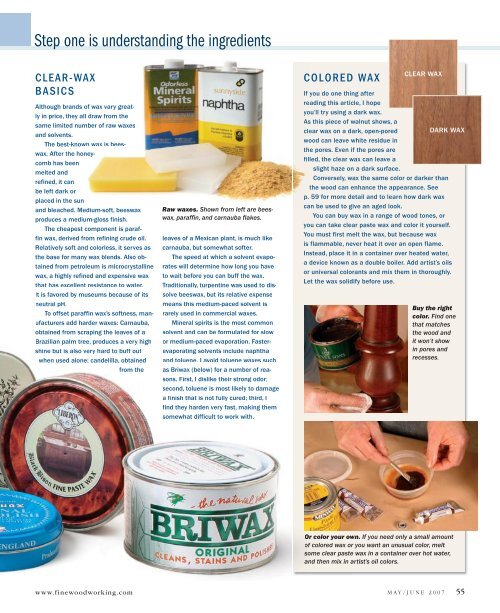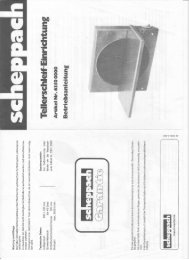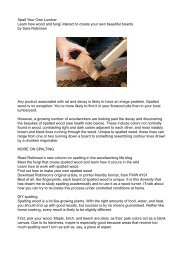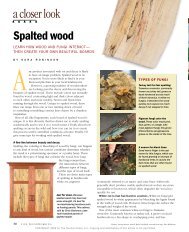Wax Primer
Wax Primer
Wax Primer
You also want an ePaper? Increase the reach of your titles
YUMPU automatically turns print PDFs into web optimized ePapers that Google loves.
Step one is understanding the ingredients<br />
CLEAR-WAX<br />
BASICS<br />
Although brands of wax vary greatly<br />
in price, they all draw from the<br />
same limited number of raw waxes<br />
and solvents.<br />
The best-known wax is beeswax.<br />
After the comb has been<br />
honeyplaced<br />
in the sun<br />
and bleached. Medium-soft, beeswax<br />
melted and<br />
refined, it can<br />
be left dark or<br />
produces a medium-gloss finish.<br />
The cheapest component is paraffin<br />
wax, derived from refining crude oil.<br />
Relatively soft and colorless, it serves as<br />
the base for many wax blends. Also obtained<br />
from petroleum is microcrystalline<br />
wax, a highly refined and expensive wax<br />
that has excellent resistance to water.<br />
It is favored by museums because of its<br />
neutral pH.<br />
To offset paraffin wax’s softness, manufacturers<br />
add harder waxes: Carnauba,<br />
obtained from scraping the leaves of a<br />
Brazilian palm tree, produces a very high<br />
shine but is also very hard to buff out<br />
when used alone; candelilla, obtained<br />
from the<br />
Raw waxes. Shown from left are beeswax,<br />
paraffin, and carnauba flakes.<br />
leaves of a Mexican plant, is much like<br />
carnauba, but somewhat softer.<br />
The speed at which a solvent evaporates<br />
will determine how long you have<br />
to wait before you can buff the wax.<br />
Traditionally, turpentine was used to dissolve<br />
beeswax, but its relative expense<br />
means this medium-paced solvent is<br />
rarely used in commercial waxes.<br />
Mineral spirits is the most common<br />
solvent and can be formulated for slow<br />
or medium-paced evaporation. Fasterevaporating<br />
solvents include naphtha<br />
and toluene. I avoid toluene waxes such<br />
as Briwax (below) for a number of reasons.<br />
First, I dislike their strong odor;<br />
second, toluene is most likely to damage<br />
a finish that is not fully cured; third, I<br />
find they harden very fast, making them<br />
somewhat difficult to work with.<br />
COLORED WAX<br />
CLEAR WAX<br />
If you do one thing after<br />
reading this article, I hope<br />
you’ll try using a dark wax.<br />
As this piece of walnut shows, a<br />
clear wax on a dark, open-pored DARK WAX<br />
wood can leave white residue in<br />
the pores. Even if the pores are<br />
filled, the clear wax can leave a<br />
slight haze on a dark surface.<br />
Conversely, wax the same color or darker than<br />
the wood can enhance the appearance. See<br />
p. 59 for more detail and to learn how dark wax<br />
can be used to give an aged look.<br />
You can buy wax in a range of wood tones, or<br />
you can take clear paste wax and color it yourself.<br />
You must first melt the wax, but because wax<br />
is flammable, never heat it over an open flame.<br />
Instead, place it in a container over heated water,<br />
a device known as a double boiler. Add artist’s oils<br />
or universal colorants and mix them in thoroughly.<br />
Let the wax solidify before use.<br />
Buy the right<br />
color. Find one<br />
that matches<br />
the wood and<br />
it won’t show<br />
in pores and<br />
recesses.<br />
Or color your own. If you need only a small amount<br />
of colored wax or you want an unusual color, melt<br />
some clear paste wax in a container over hot water,<br />
and then mix in artist’s oil colors.<br />
www.finewoodworking.com<br />
M A Y / J U N E 2 0 0 7<br />
55
















